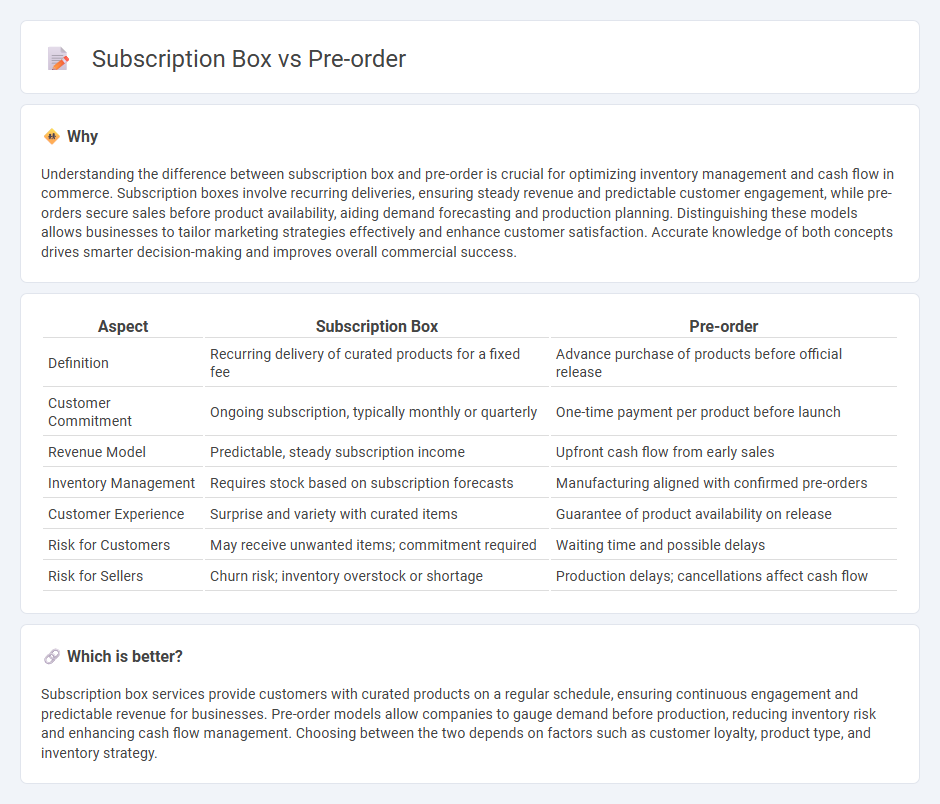
Subscription boxes offer recurring, curated product deliveries that enhance customer convenience and loyalty, providing predictable revenue streams for businesses. Pre-orders, on the other hand, allow consumers to reserve upcoming products ahead of release, aiding in demand forecasting and inventory management. Explore the advantages of subscription boxes and pre-orders to determine the ideal strategy for your commerce goals.
Why it is important
Understanding the difference between subscription box and pre-order is crucial for optimizing inventory management and cash flow in commerce. Subscription boxes involve recurring deliveries, ensuring steady revenue and predictable customer engagement, while pre-orders secure sales before product availability, aiding demand forecasting and production planning. Distinguishing these models allows businesses to tailor marketing strategies effectively and enhance customer satisfaction. Accurate knowledge of both concepts drives smarter decision-making and improves overall commercial success.
Comparison Table
| Aspect | Subscription Box | Pre-order |
|---|---|---|
| Definition | Recurring delivery of curated products for a fixed fee | Advance purchase of products before official release |
| Customer Commitment | Ongoing subscription, typically monthly or quarterly | One-time payment per product before launch |
| Revenue Model | Predictable, steady subscription income | Upfront cash flow from early sales |
| Inventory Management | Requires stock based on subscription forecasts | Manufacturing aligned with confirmed pre-orders |
| Customer Experience | Surprise and variety with curated items | Guarantee of product availability on release |
| Risk for Customers | May receive unwanted items; commitment required | Waiting time and possible delays |
| Risk for Sellers | Churn risk; inventory overstock or shortage | Production delays; cancellations affect cash flow |
Which is better?
Subscription box services provide customers with curated products on a regular schedule, ensuring continuous engagement and predictable revenue for businesses. Pre-order models allow companies to gauge demand before production, reducing inventory risk and enhancing cash flow management. Choosing between the two depends on factors such as customer loyalty, product type, and inventory strategy.
Connection
Subscription boxes and pre-orders are connected through their ability to create predictable revenue streams and enhance customer commitment in e-commerce. Both strategies allow businesses to gauge demand in advance, optimizing inventory management and reducing overstock risks. By leveraging pre-orders within subscription models, companies ensure timely product delivery while fostering stronger customer relationships and personalized shopping experiences.
Key Terms
Payment Model
Pre-orders typically require a one-time payment upfront for a specific product, ensuring guaranteed delivery upon release. Subscription boxes operate on a recurring payment model, charging customers at regular intervals for curated selections of products. Explore the benefits and drawbacks of each payment system to find the best fit for your shopping preferences.
Inventory Management
Pre-order inventory management allows businesses to accurately forecast demand and reduce overstock by producing items only after customer orders are confirmed. Subscription boxes require maintaining a diversified inventory to meet recurring delivery schedules, balancing product variety with storage constraints to optimize fulfillment efficiency. Explore strategies to enhance your inventory management for both pre-order and subscription models.
Customer Commitment
Pre-orders require a one-time payment before product release, offering customers control over purchase timing without ongoing obligations. Subscription boxes involve recurring payments, fostering long-term customer commitment through regular product delivery and curated experiences. Explore how these models impact customer loyalty and business growth strategies.
Source and External Links
Kindle eBook Pre-Order - Kindle Direct Publishing - Pre-order allows customers to order an eBook up to one year before its release, with books delivered automatically on release day and pre-orders contributing to sales rank and visibility even before launch.
Pre-order - Wikipedia - A pre-order is an order placed for an item not yet released, enabling customers to reserve it in advance, securing immediate shipment upon release, and often includes marketing incentives to encourage early purchase.
Understanding What Does Pre Order Mean? - A pre-order is purchasing a product before its release or production, useful for businesses to forecast demand and for consumers to secure products in advance, often with deposits or full payment made upfront.
 dowidth.com
dowidth.com